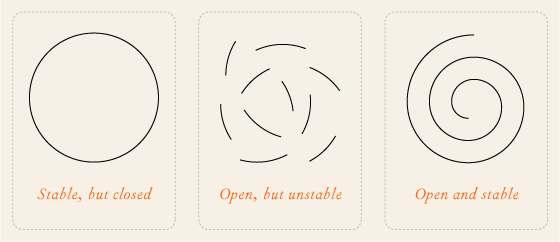I am making a list of some strange phenomena which are the daily fare of strategic designers, but which are seldom experienced outside the field, at least not in the way designers experience them. By designers, I mean anyone engaged in human-centered design. These phenomena do not occur at the same intensity and frequency in problems that do not explicitly contend with subjectivity. Designers must live with them at full intensity, for long durations, without any easy escape route. Here is the list, so far:
- Dependency on conceptual models (which I will just call “models”) to guide the forming of a system that is experienced as clear and coherent to those who participate in them
- Uncanny difficulties in agreeing on models among members of design teams, which render subjective differences stark
- Difficulties in interpreting phenomena, and especially subjective phenomena, among different team members
- Difficulties in weighing design tradeoffs among different team members
- Existential pain associated with relinquishing (or even temporarily suspending) models that one has adopted — even in order to listen and understand another perspective — a phenomenon that can be called “pluralistic angst”
- Dependence on profound respect, trust and goodwill among team members to navigate through and out of pluralistic angst
- Tactics employed by well-intentioned people to avoid the pain and effort required to overcome pluralistic angst
- The ubiquity and invisibility of models — and the best models are the most ubiquitous and the most invisible — not only in design, but all understanding, which only becomes detectable in pluralistic conflict
- The miraculous way truths and unnoticed realities leap from nowhere (ex nihilo) when a different model is adopted and used
- The weird way a change in a sufficiently foundational model can sometimes change (transfigure) the meaning of one’s life as a whole, even when the change is meant only to affect a localized problem
- The fact that there are no determinate techniques, rules, criteria to overcome pluralistic angst (though there are approaches that can assist the process) — that people are thrown back into their bare unequipped souls to find the resources needed to overcome it together
- The solidarity among team members which can result from overcoming pluralistic angst with respect, trust and goodwill
Anyone who has been through the harrowing experiences described about enough times 1) to recognize what is happening, 2) to find faith that these things can be overcome, 3) to understand the value of overcoming them, 4) to find the attitude of soul most conducive to overcoming them (which includes grace toward one’s own missteps, doubts and moral failings during the process) might start seeing similar phenomena everywhere, at all scales, from international politics to personal relationships to one’s own inner conflicts. Or, at least this is what happened to me.
I was driven deep into existential philosophy, including phenomenology and hermeneutics then into pragmatism and its offshoots in social science to try to understand the weird kinds of pain I experience as a designer. Philosophy has never been speculative or abstract to me. It is concrete, near and a matter of life and death.
As a result of this search for understanding, I have designed myself conceptual models to help me re-understand the human condition as largely one of conflicting conceptual models.
It is here that it becomes fairly obvious how philosophy and design connect and merge into something inseparable. That is what I plan to write about and publish next, now that I have crystallized my core conceptual models in the form I believe they deserve.





